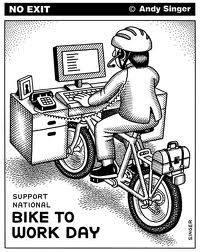
If there is one public policy issue on which Scott Walker and Republicans in general are totally out of touch with reality, it's mass transit. They actively oppose a balanced state and national transportation policy that makes sense for the 21st Century. And in Wisconsin's case, that opposition is going to cause environmental and economic harm, across the state and especially our cities.
That is becoming increasingly clear as policy experts examine how public attitudes are changing towards transportation and the way communities are designed. From the Reuters news service:
U.S. residents started driving less around the turn of the 21st century, and young people have propelled this trend, according to the federal government's National Household Travel Survey.
From 2001 to 2009, the average annual number of vehicle-miles traveled by people ages 16-34 dropped 23 percent, from 10,300 to 7,900, the survey found. Gen Y-ers, also known as Millennials, tend to ride bicycles, take public transit and rely on virtual media.
More than a quarter of Millennials — 26 percent — lacked a driver's license in 2010, up 5 percentage points from 2000, the Federal Highway Administration reported.
http://news.yahoo.com/americas-generation-y-not-driven-drive-145632280-…
Thus, if you're a Republican who thinks a driver's license is the ultimate form of voter ID, you're not only making it harder to those younger Americans to participate in the electoral system, you're making it harder for them to make a living, And they're already tasked by daunting rises in the cost of simply getting around, rises not matched by stagnant or declining salaries.
Meanwhile, if you're a Democrat proud of pushing legislation that was successful in rescuing two of America's big three automakers from bankruptcy, you need to start considering whether the domestic automobile market may be shrinking significantly in coming years, unless technology and cultural norms keep on changing some more.
When many congressional Republicans finally got off their ham hocks last week and agreed with unanimous Democrats to pass a two-year, $100 billion federal surface-transportation bill, House GOP members were forced to give up on their efforts to includet wo anti-environmental riders. One would have advanced the environmentally dangerous Keystone XL oil pipeline from Canada, the other would have banned regulation of toxic coal ash waste from power plants. Nevertheless, antediluvian members managed to prevent progress toward a more balanced transportation system.
The final version of the bill seriously trimmed funding for bicycle paths, pedestrian walkways and other alternative transportation infrastructure. It also reduces funds for repairing roads and bridges, when the US highway system is already crumbling. The bill also suspends environmental reviews of highway and transit projects costing less than $5 million, in violation of existing environmental laws. Mass transit funding basically was preserved at existing levels, but that's historically been too little to maintain existing systems, much less expand them to meet growing demand.
Even these regressive components weren't enough to get GOP Rep. Jim Sensenbrenner and GOP Sen. Ron Johnson to vote for the measure.
As the New York Times noted in an editorial, the bill also fails to provide solid long-term footing for the nation's transportation network because it continues to fund those systems primarily via the Highway Trust Fund, which collects 18.4 cents per gallon in excise tax on gasoline. Tha's a funding source that's ultimately in jeopardy as transport costs increase but funding declines as Americans rely less on petroleum. And politicians appear not to be paying close attention to these trends, spotted by urban planners and others.
Why are younger Americans increasingly hesitant to drive cars? The Michigan study referenced by Reuters said it has mostly to do with the high cost of owning and operating a car, versus the convenience of electronic communication. Again, from Reuters:
The Frontier Group's Dudzik suggested a related cause: computer and smartphone applications that make taking public transportation easier, with minute-by-minute tracking of buses and trains and simple online maps and travel directions.
Whether Gen Y-ers will eventually drive more than they do now will affect transportation infrastructure costs, Dudzik said.
Bikes and car-sharing services make it easier to avoid the expense of owning a fossil-fueled vehicle. Environmental concerns are another reason, said David Jacobs of the Tombras Group, a marketing firm based in Knoxville, Tennessee ... . More central is the group's general anxiety over finances and the economy, he said.
Meanwhile, Judith Rodin in The Atlantic magazine reported:
Within three years, over 15 million Americans above the age of 65 – for whom transportation options are essential and even life-saving – will live in communities where public transportation is poor or woefully insufficient. As Baby Boomers age, this number will only get bigger. And racial minorities, who will be the country’s majority in a few decades, are four times more likely to use public transportation to commute to work. These are the Americans we should be thinking about and building 21st century infrastructure for, yet we continue to fund and build the wrong things – highways – focusing on the needs of the loudest lobby rather than the needs of the next generation of Americans... .
America is also being left behind by the rest of the world. Developed countries are committing billions of dollars in 21st century transportation and infrastructure spending. At the recent UN conference on sustainability and development in Rio, the eight largest multilateral development banks committed to lending $175 billion over the next decade to mass transit projects in the developing world, both increasing access to opportunity and reducing pollution.
Another Atlantic article by "creative class"guru Richard Florida provided buttressing statistics:
Young people are also making more use of transit, bikes, and foot power to get around. In 2009, 16 to 34-year-olds took 24 percent more bike trips than they took in 2001. They walked to their destinations 16 percent more often, while their passenger miles on transit jumped by 40 percent.
A survey by the National Association of Realtors conducted in March 2011 revealed that 62 percent of people ages 18-29 said they would prefer to live in a communities with a mix of single family homes, condos and apartments, nearby retail shops, restaurants, cafes and bars, as well as workplaces, libraries, and schools served by public transportation. A separate 2011 Urban Land Institute survey found that nearly two-thirds of 18 to 32-year-olds polled preferred to live in walkable communities.
Let's hope lawmakers -- especially Republicans -- get on the clue train before it leaves the station. However, given the GOP's recent track record on trains and mass transit, that seems unlikely.
